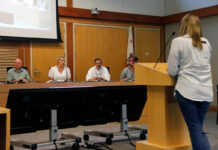At an event in the Plaza in 2005 a trio of questions were asked, in English and Spanish of the almost 1,000 attendees. To the question What single change would most improve the quality of your life in Healdsburg? (¿Qué cosa mejoraría la calidad de su vida en Healdsburg?) The most frequent answer written on the chart pads was overwhelmingly, “Affordable housing.”
The Growth Management Ordinance (GMO) never prevented the city from building state defined “affordable housing” – projects that require significant subsidies. Since 2000 177 affordable units were built and added to the 272 existing, bringing the total of deed restricted dwellings in Healdsburg to 429. On a per capita basis, Healdsburg outperformed most other cities in the county. Until it was dismantled by the state, redevelopment funds enabled Healdsburg to build more than its share of affordable housing units.
When it passed in 2000, the GMO set a limit of an average of 30 residential permits per year, with no more than 90 allocations in three years; a rather blunt instrument. It effectively eliminated proposals for multi-family housing, apartments and condominiums. Why? Because the uncertainties associated with getting those 30 allocations would lead a developer to choose a safer course. Allocations are assigned when applying for a building permit. But a permit application comes after buying the land, proposing a project, extensive engineering, design reviews and construction documents. All of which are expenses without the certainty of completion. The GMO greatly increased risk for anything but single family homes. The result is that there have been no market rate multi-family units built – for sale or rent – since the GMO was passed.
Over the last year, as vice chair of the Community Housing Committee, the complexity of the housing construction process became abundantly clear. How complex? Does a grandfather clock keep accurate time because you pull the weight down once a week? No. Behind the door there is a system of gears and springs which keep the time. Just looking at the clock does not explain why it keeps time. Just limiting residential construction with a number does not provide the diversity of housing a community needs to remain vital.
To build housing in Healdsburg (or anywhere) you must navigate the regulatory environment that controls development. The intersection of many statutory and policy guidelines are what make it complex: the general plan, zoning, plan overlays, design guidelines, building codes, fee schedules, property rights, rental control measures, taxes and affordable housing controls (Inclusionary Housing Ordinance). Many interdependent parts. Not to mention a lender’s requirements for financing.
The existing GMO allows for no intervention by the city to correct an imbalance in the types of housing being built. The GMO may have had a modest influence on the rising prices of Healdsburg real estate. Gourmet Magazine and Sunset may have contributed too. But it definitely prevented developers from proposing apartments or condominiums. Without the GMO the Passalacqua property might have become something other than Saggio Hills. That parcel had previously been zoned for several hundred homes.
The focus of the Community Housing Committee’s work was to understand how to correct the shortage of moderately priced housing in Healdsburg. What would it take to incentivize developers to build housing affordable to families that do not qualify for subsidized housing? After months of talking about numbers and detailed proposals to modify the existing GMO, it became clear that what was needed were tools to drive the development of housing types that have not been built for 15 years.
We proposed an interdependent set of actions to encourage more modestly priced housing. Measure R eliminates the existing, blind GMO limits. To replace this limit a Housing Action Plan (HAP) was drafted and adopted by the City Council. It sets goals for residential construction over the next six years. The HAP uses data collated in the Housing Element, a state mandated assessment required every eight years. The HAP is the strategy for driving the development of needed residential types.
To implement the strategy of the HAP, the Growth Regulation Ordinance provides specific targets for new housing. Over the next six years there are only 80 allocations for conventional detached single family residences. The other 340 allocations are for multi-family apartments and condos, cottage courts and other creative solutions to create more affordable residences. These targets inform developers that the city wants project proposals that are “affordable by design” – that meet the needs of those unable to find housing in Healdsburg today.
Measure R also adds a new tier to affordable housing, one not recognized by the State. It increases the Inclusionary Housing Ordinance to 30 percent from 15 percent. Developers of market rate units will be required to deliver an additional 15 percent of units available to families whose income is higher than the HUD ceiling, but not enough to buy a home in Healdsburg’s expensive home market.
Imagine if the Sorrento development on Healdsburg Avenue was configured differently. If instead of the 28 homes there, (1,600 square feet to 1,800 square feet, priced at $700,000 to $850,000) there were 56, half as large, half as expensive. This overly simplified example (ignores density, parking, attached, height, etc.) is what the city wants developers to propose. It is what “affordable by design” could look like. The developer could not have proposed such a solution under the GMO with confidence they would get the necessary allocations.
The NO on R campaign has blurred the central issues by using fear and exaggeration to paint a picture of runaway growth, fearing a city council deaf to the will of the community. The idea that three council members could change the Growth Regulation Ordinance isn’t news. This is the structure of our government system. They could also double water and electric rates, reduce the size of the police force, put in parking meters and cut down trees in the Plaza to make room for more visitors to Tuesday concerts.
The truth is that over the last four decades many city councils contributed to the community which we cherish today. In response to what was said at more than 25 workshops, meetings, and hearings over the last two years, the Housing Action Plan identifies what the community said was needed in the housing marketplace. We have a more responsive government than most others in the county. Governing by initiative is a deadly, inflexible process. It ignores the true complexity of modern life.
The GMO prevents implementing tools that could lead developers to the middle income housing we are missing. The GMO is a rigid structure for controlling growth, the Housing Action Plan is a strategic framework for actually managing growth, something that can be modified as conditions change. Voting no on Measure R gives voters one chance to shout loudly on Nov. 8, and later bemoan that the housing crisis has persisted. It is my fervent hope that voters recognize that keeping the GMO will result in more of what we have experienced in the last 15 years.
By voting yes on Measure R, the citizens of Healdsburg can have an ongoing role in how development occurs. Voting yes on Measure R holds the promise of improving the housing availability for our friends’ children, seniors, the staffs at our favorite restaurants, not to mention city and school district employees. It can do that because of all the gears and springs behind the door to make the changes we want in our housing inventory. Please stop and think twice before believing that Healdsburg’s housing crisis can be answered with only a binary choice between no or yes. Consider carefully why we have had no moderate income multi-family housing built in 15 years.
— Richard Burg is a Healdsburg resident








